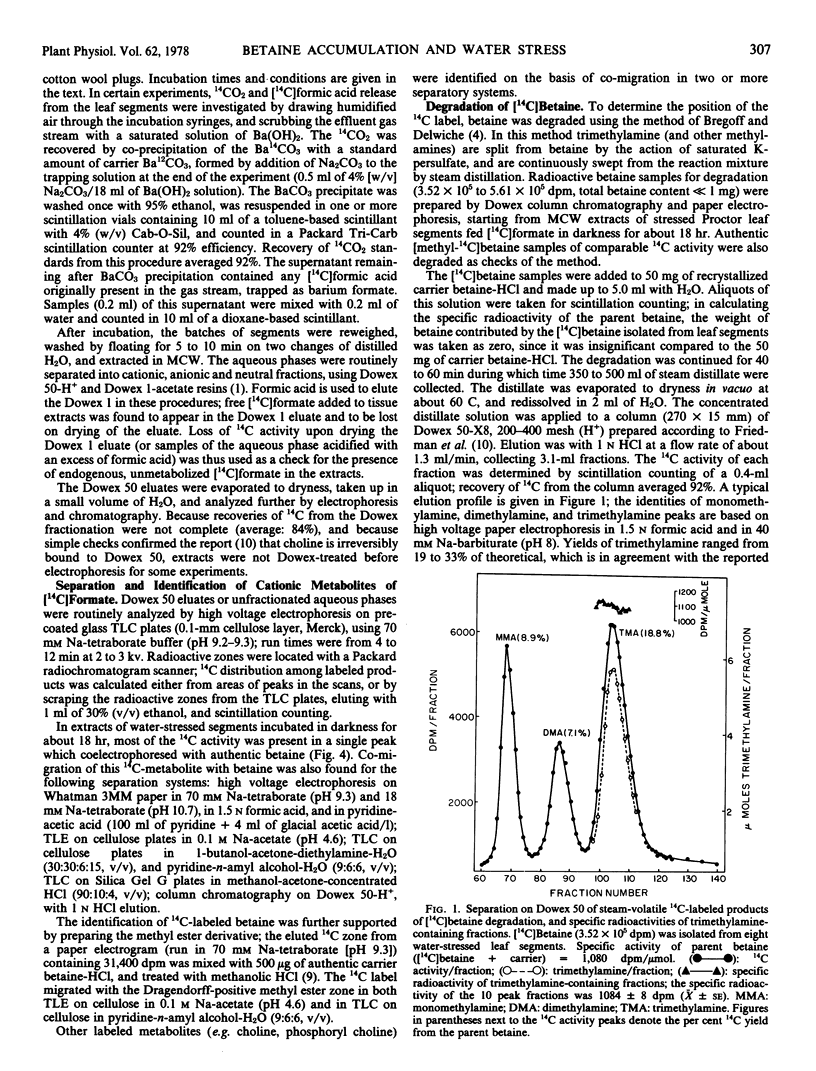Abstract
Barley (Hordeum vulgare L.) plants at the three-leaf stage were water-stressed by flooding the rooting medium with polyethylene glycol 6000 with an osmotic potential of −19 bars, or by withholding water. While leaf water potential fell and leaf kill progressed, the betaine (trimethylglycine) content of the second leaf blade rose from about 0.4 micromole to about 1.5 micromoles in 4 days. The time course of betaine accumulation resembled that of proline accumulation. Choline levels in unstressed second leaf blades were low (<0.1 micromole per blade) and remained low during water stress. Upon relief of stress, betaine-like proline—remained at a high concentration in drought-killed leaf zones, but betaine did not disappear as rapidly as proline from viable leaf tissue during recovery.
When [methyl-14C]choline was applied to second leaf blades of intact plants in the growth chamber, water-stressed plants metabolized 5 to 10 times more 14C label to betaine than control plants during 22 hours. When infiltrated with tracer quantities of [14C]formate and incubated for various times in darkness or light, segments cut from water-stressed leaf blades incorporated about 2- to 10-fold more 14C into betaine than did segments from unstressed leaves. In segments from stressed leaves incubated with [14C]formate for about 18 hours in darkness, betaine was always the principal 14C-labeled soluble metabolite. This 14C label was located exclusively in the N-methyl groups of betaine, demonstrating that reducing equivalents were available in stressed leaves for the reductive steps of methyl group biosynthesis from formate. Incorporation of 14C from formate into choline was also increased in stressed leaf tissue, but choline was not a major product formed from [14C]formate.
These results are consistent with a net de novo synthesis of betaine from 1- and 2-carbon precursors during water stress, and indicate that the betaine so accumulated may be a metabolically inert end product.
Full text
PDF







Selected References
These references are in PubMed. This may not be the complete list of references from this article.
- BREGOFF H. M., DELWICHE C. C. The formation of choline and betaine in leaf disks of Beta vulgaris. J Biol Chem. 1955 Dec;217(2):819–828. [PubMed] [Google Scholar]
- Boggess S. F., Stewart C. R. Effect of water stress on proline synthesis from radioactive precursors. Plant Physiol. 1976 Sep;58(3):398–401. doi: 10.1104/pp.58.3.398. [DOI] [PMC free article] [PubMed] [Google Scholar]
- Byerrum R. U., Sato C. S., Ball C. D. Utilization of Betaine as a Methyl Group Donor in Tobacco. Plant Physiol. 1956 Sep;31(5):374–377. doi: 10.1104/pp.31.5.374. [DOI] [PMC free article] [PubMed] [Google Scholar]
- DELWICHE C. C., BREGOFF H. M. Pathway of betaine and choline synthesis in Beta vulgaris. J Biol Chem. 1958 Aug;233(2):430–433. [PubMed] [Google Scholar]
- FRIEDMAN S., MCFARLANE J. E., BHATTACHARYYA P. K., FRAENKEL G. Quantitative separation and identification of quaternary ammonium bases. Arch Biochem Biophys. 1955 Dec;59(2):484–490. doi: 10.1016/0003-9861(55)90514-2. [DOI] [PubMed] [Google Scholar]
- Felker P., Bandurski R. S. Quantitative gas-liquid chromatography and mass spectrometry of the N(O)-perfluorobutyryl-O-isoamyl derivatives of amino acids. Anal Biochem. 1975 Jul;67(1):245–262. doi: 10.1016/0003-2697(75)90292-4. [DOI] [PubMed] [Google Scholar]
- Morris C. J., Thompson J. F., Johnson C. M. Metabolism of Glutamic Acid and N-Acetylglutamic Acid in Leaf Discs and Cell-free Extracts of Higher Plants. Plant Physiol. 1969 Jul;44(7):1023–1026. doi: 10.1104/pp.44.7.1023. [DOI] [PMC free article] [PubMed] [Google Scholar]
- Nelsen C. E., Safir G. R., Hanson A. D. Water potential in excised leaf tissue: comparison of a commercial dew point hygrometer and a thermocouple psychrometer on soybean, wheat, and barley. Plant Physiol. 1978 Jan;61(1):131–133. doi: 10.1104/pp.61.1.131. [DOI] [PMC free article] [PubMed] [Google Scholar]
- ROSEN H. A modified ninhydrin colorimetric analysis for amino acids. Arch Biochem Biophys. 1957 Mar;67(1):10–15. doi: 10.1016/0003-9861(57)90241-2. [DOI] [PubMed] [Google Scholar]
- Singh T. N., Aspinall D., Paleg L. G. Proline accumulation and varietal adaptability to drought in barley: a potential metabolic measure of drought resistance. Nat New Biol. 1972 Apr 12;236(67):188–190. doi: 10.1038/newbio236188a0. [DOI] [PubMed] [Google Scholar]
- Stewart C. R., Morris C. J., Thompson J. F. Changes in Amino Acid Content of Excised Leaves During Incubation. III. Role of Sugar in the Accumulation of Proline in Wilted Leaves. Plant Physiol. 1966 Dec;41(10):1585–1590. doi: 10.1104/pp.41.10.1585. [DOI] [PMC free article] [PubMed] [Google Scholar]
- Stewart C. R. Proline Content and Metabolism during Rehydration of Wilted Excised Leaves in the Dark. Plant Physiol. 1972 Dec;50(6):679–681. doi: 10.1104/pp.50.6.679. [DOI] [PMC free article] [PubMed] [Google Scholar]
- TOLBERT N. E. Formic acid metabolism in barley leaves. J Biol Chem. 1955 Jul;215(1):27–34. [PubMed] [Google Scholar]
- Thomas T. D., Batt R. D. Synthesis of protein and ribonucleic acid by starved Streptococcus lactis in relation to survival. J Gen Microbiol. 1969 Nov;58(3):363–369. doi: 10.1099/00221287-58-3-363. [DOI] [PubMed] [Google Scholar]


